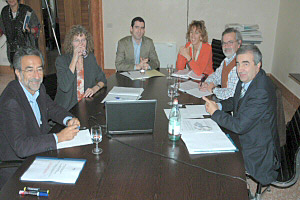Submitted by S. Heise, editor of the Sediment Corner, SETAC Globe, authored by Piet den Besten (RIZA, the Netherlands) and Sabine Apitz (SEA Environmental Decisions Ltd, UK)
Sediments are an essential, integral and dynamic part of hydrologic systems, which provide connections between land, rivers, estuaries and the sea. Whilst for decades, many scientists have treated the complex and abundant biota in the vast soil and sediment ecosystems that cover this planet as ‘black boxes’, these millions of species are critical to the maintenance of essential ecosystem services such as carbon sequestration, nutrient cycling, soil and shoreline stabilization and water purification1. The functioning and health of these ecosystems, and their ability to deliver services are intimately linked to sediment quality, quantity, and dynamic balance. It is clear that human activities, from the local to the global scale, are affecting biodiversity and functioning, and that sectoral management of soils and sediments in support of one ecosystem service, such as abstraction, dredging, forestry, etc., can negatively impact other services, either in that system, or in other connected systems. However, to what extent this is so is not clear, nor do most of our soil and sediment assessments address this issue 2.Because of their ability to transport and accumulate contaminants, much of the regulatory attention related to sediments has been on their quality, and thus in the first three years of SedNet 3 contaminated sediments in freshwater systems were the main focus. However, it is clear that sectoral management decisions such as the damming of rivers, dredging of waterways, abstraction and many other activities can have significant hydromorphological effects that can impact ecosystem functioning due to sediment excess or lack. Thus, to achieve the objectives of European ecosystem-based policy such as the Water Framework Directive (WFD), the Marine Strategy Directive (MSD), the Habitats Directive (HSD), Integrated Coastal Zone Management (ICZM) and others, it is essential that more attention is paid to the connecting role of sediments, from land to the sea. To achieve good ecological status or potential and to support the well-being of the European economy at the same time, sustainable sediment management is important.
 To continue to encourage integrated thinking on river basin management, the now self-funded SedNet held a round-table discussion entitled “Sediment Management – an Essential Part of River Basin Management Plans” form the 22nd to 23rd of November, 2006, in Venice, Italy. Immediately following, to address their new, expanded focus, SedNet organized an open scientific conference “Sediment key-issues between the river and the sea” from the 23rd to 24th of November. Both were hosted by UNESCO at the Palazzo Zorzi.
To continue to encourage integrated thinking on river basin management, the now self-funded SedNet held a round-table discussion entitled “Sediment Management – an Essential Part of River Basin Management Plans” form the 22nd to 23rd of November, 2006, in Venice, Italy. Immediately following, to address their new, expanded focus, SedNet organized an open scientific conference “Sediment key-issues between the river and the sea” from the 23rd to 24th of November. Both were hosted by UNESCO at the Palazzo Zorzi.
Footnotes:
1. Wall DH (ed) (2004): Sustaining Biodiversity and Ecosystem Services in Soils and Sediments. Island Press, Washington, DC, 275 p
2. S E Apitz (2006) Challenges in the INTERCOMP area. Journal of Soils and Sediments 6(4)
3. The EC Framework 6, demand-driven sediment research network; www.sednet.org.
Round-Table discussion: Sediment Management – an Essential Part of River Basin Management Plans
The Round-Table session brought together invited river basin managers, user group representatives and scientists from four selected European river basins, Danube, Douro, Elbe and Humber, to discuss their interests, challenges, expectations and how to move forward in sediment management at the river basin scale. The WFD requires that River Basin Management Plans (RBMP) be produced and published by 2009. If SedNet’s goal that sediment management (quality and quantity) becomes a part of these plans is to be achieved there is a need for scientific and practical guidance on how to consider sediment management issues. An objective of the round-table discussions, then, was to use real world examples to develop conceptual approaches on how to address sediment related issues based on legal requirements, the needs of users and scientific advice.
 The 23 current member states of the EC have 96 River Basin Districts (RBDs), 27 of them crossing international boundaries. Other European countries that wish to adopt European Union approaches, and the proposed accession countries, bring dozens more RBDs into the equation. However, a recurring theme in discussions of the case studies was that each case was unique, for scientific, socioeconomic and political reasons, and there was great concern that a “one size fits all” European approach is not imposed upon all areas. Sediment quality (due to contaminants and nutrients) was a focus of concern in three of the case studies, and there was a recognition of the need for better understanding and control of current and historical sources of contaminants, even when this involved international and cross-regional cooperation. However, more discussion focused on issues of sediment balance. Often in the same river basin, different areas had opposite sediment quantity issues – activities such as dredging and reservoir flushing were causing ecological impacts such as smothering, habitat loss and light attenuation, whilst downstream sediment lack was causing erosion or loss of wetlands and other critical habitat or coastal protection. There was clear recognition that there is a need to better understand sediment sources, dynamics and their interactions with both human management and ecosystem functioning and services. At the same time, there was recognition that human intervention such as dredging could not cease, and that solutions needed to be both ecologically and economically sustainable. In all the case studies, there was a recognition that this would require creative communication and collaboration between various sectors, and that, although not all objectives were achievable, win-win situations must be sought.
The 23 current member states of the EC have 96 River Basin Districts (RBDs), 27 of them crossing international boundaries. Other European countries that wish to adopt European Union approaches, and the proposed accession countries, bring dozens more RBDs into the equation. However, a recurring theme in discussions of the case studies was that each case was unique, for scientific, socioeconomic and political reasons, and there was great concern that a “one size fits all” European approach is not imposed upon all areas. Sediment quality (due to contaminants and nutrients) was a focus of concern in three of the case studies, and there was a recognition of the need for better understanding and control of current and historical sources of contaminants, even when this involved international and cross-regional cooperation. However, more discussion focused on issues of sediment balance. Often in the same river basin, different areas had opposite sediment quantity issues – activities such as dredging and reservoir flushing were causing ecological impacts such as smothering, habitat loss and light attenuation, whilst downstream sediment lack was causing erosion or loss of wetlands and other critical habitat or coastal protection. There was clear recognition that there is a need to better understand sediment sources, dynamics and their interactions with both human management and ecosystem functioning and services. At the same time, there was recognition that human intervention such as dredging could not cease, and that solutions needed to be both ecologically and economically sustainable. In all the case studies, there was a recognition that this would require creative communication and collaboration between various sectors, and that, although not all objectives were achievable, win-win situations must be sought.
There is a need for wide recognition that the current “at risk” classification within the WFD is a screening level, which should trigger spatial discrimination, further study of effects and tests of the significance of impacts. This requires an evidence-based approach to link sediment state to impacts, and integrated thinking about rivers and transitional waters. There is a need to collate available data to identify knowledge gaps and enhance understanding, linking sediment management to environmental and climate change issues, without compromising the ability of the system to respond. This requires an adaptive management approach.
In summary, sediment was found to be an important issue in all of the four river basins (and in others discussed), but each river basin has specific characteristics; therefore sediment management will differ in each. Estuaries are different from rivers; there was a feeling from those who manage estuaries that the past river basin focus of SedNet resulted in too much ‘fluvial’ thinking thus far. Whilst many lessons learned will be of relevance, differences can be expected in coasts and estuaries, especially in terms of time scales, effectiveness of measures, and the closer linking of sediment management to environmental/climate change issues on the coast. It was agreed that integration of the requirements of different directives will be difficult for river basin managers and users, but that this is essential if their objectives are to be met.
Another discussion point was the development and use of sediment environmental quality standards (EQS). These should be regarded as high level screening values; the start of diagnostics (using tiered approaches). It is essential to use different lines of evidence, and to link sediment state to impacts, and thus a good understanding of the system is necessary. The role of EQS is different in upstream parts of the river basin to that in downstream parts (estuaries), and EQS may not be appropriate for sediments in highly variable situations where measurable state-impact links are not well understood. A further concern was that EU Policies may create conflicting ambitions, for instance between the environment, transport and health objectives.
Finally, the round-table concluded that achieving good ecological status requires a proper attention to sediment issues, with an awareness of natural variation and differences between catchments. Current WFD “at risk” classifications of water bodies require further spatial definition and a linkage of risk to impact. Those involved in transitional water management need better engagement with those involved with river management (and vice versa). There is a requirement to collate available data to identify knowledge gaps and enhance understanding. Finally, it was felt that the EU should not only fund problem identification, but also problem solving processes.
The outcome of the Round-Table discussion will be presented at the seminar “Navigation and the EU Water Framework Directive” organised by PIANC on 31 January 2007 in Brussels.

